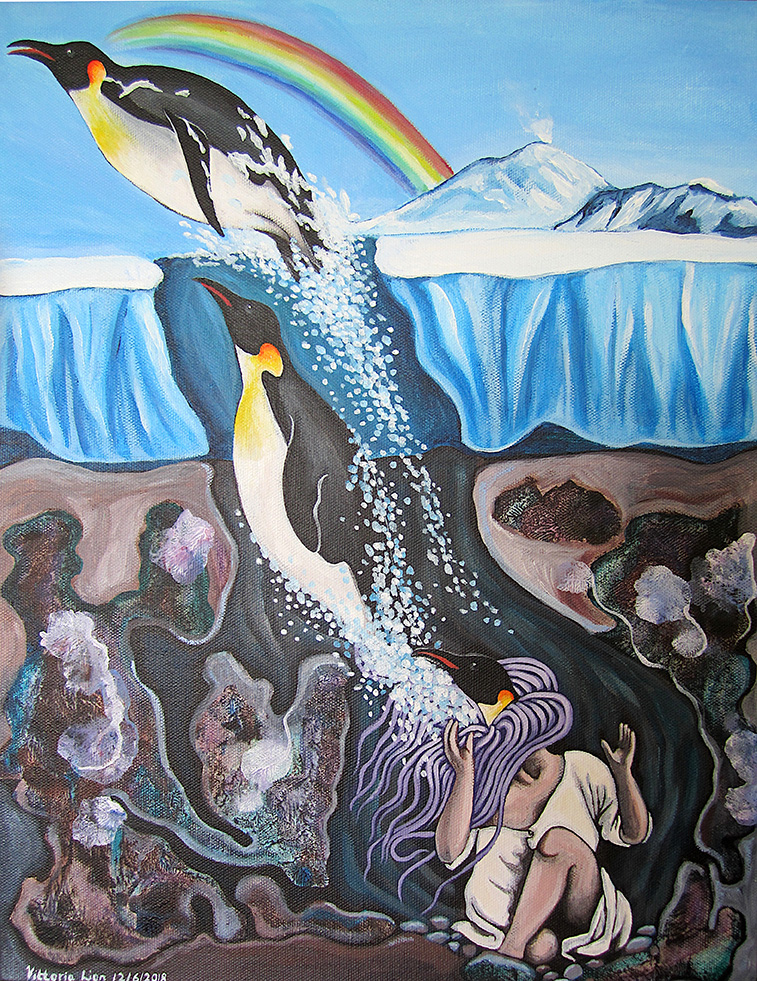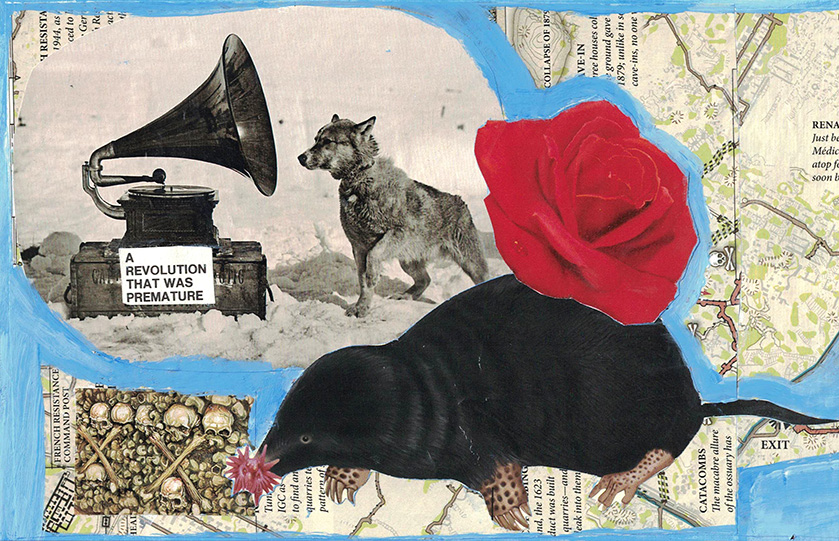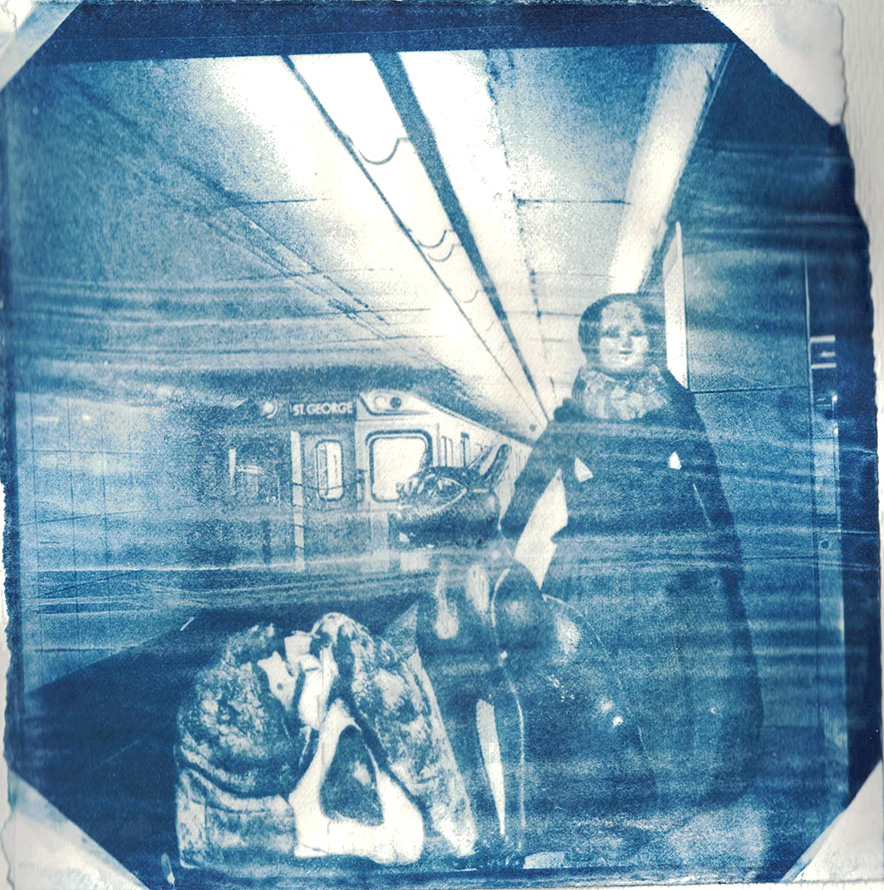Vittoria Lion
Mundus Subcutaneous
Awake in bed one night, it occurred to me that perhaps the Anthropocene began in the halls of the Salpêtrière—the uncovering of a vast sleep geology, a project simultaneously underway with the discovery of immense skeletons during the assemblage of railroad tracks. A flock of hysterics, like the dinosaurs, thus became the ancestors of iridescent birds.
It’s another day in the boiling city, where pinnacles of human feces reach to the sky and stacks of unwashed dishes substitute for skyscrapers. Weathervane wolves listen to the humming of pipelines. The sun whirls out of control, casting shadows over antelope and early hominids. New constellations give way to older ones seen by the painters of sandbanks and torched forests. Human worms dig tunnels between the mantle and topsoil, churning an earthy soup and battling gigantic moles.
Subterranean dwelling is life inside a magic mirror somewhere between hell and utopia. To me, Father Kircher was always colossal, fictional, and shrouded, like my country of origin. After all, I knew the Collegio Romano is in Italy and that he carved a museum there out of raw memory. I am continually enchanted by his explorations of Mount Vesuvius and Mount Etna, where he encountered firsthand the same paroxysms of tectonic seduction that Breuer would use as a metaphor centuries later.
There is a certain fantasy I had as a very young child that I remember with clarity. When I rode the subway, I imagined that it was in fact threading through the deep darkness of the oceanic trenches lying along the East Pacific Rise, and the fluorescent lights streaming past the cabin window were the bioluminescence of anglerfish and jellies. Nearly two decades later, in my dream I was riding a train that ran across the Atlantic from here to Paris, either submerged in the abyssal zone or buried under the ocean floor. The cabin I sat in was decorated with posters of the wonders housed in the Musée des Arts et Métiers and Teophilus Schweighardt Constantiens’ engraving of the Temple of the Rose Cross. In another dream, I explored the catacombs and peered into dimly-lit chambers where the leathery bodies of the upturned Cimetière des Innocents were replaced by analogy with chaotic piles of vellum manuscripts inscribed with the unsaid name mouldering into nothingness. The underground derives its magic airlessness largely from the presence of the dead. In other words, I was no different from every other child who looked out the window and daydreamed about where they would have to move if somebody dug up a dinosaur skeleton beneath the house and secretly wished it would happen anyways.
I have produced these three images to elucidate my fixation on all things underground. The first, a painting titled The Other Side of the Rainbow, is my attempt to visualize the hysteria-to-penguins dialectic of the elder and younger Charcot. It reveals a cross-section of the Antarctic underground teeming with fossil vegetation. Above is an ice sheet punctuated by the opening of a glacial pool leading down into the rock below. Louise Augustine Gleizes is at the bottom of the pool, holding the orans posture from the iconic 1878 photograph of her, but her head is replaced with a purple anemone from which an emperor penguin is emerging. Above her, two recently-birthed emperors launch out of the water and onto the ice. Mount Erebus is seen smoking in the background against a rainbow. At the Mountains of Madness was a double entendre.
The second image is a souvenir from a revolution that was premature. Marx’s “old mole” (here seen in the form of a star-nosed mole) is juxtaposed with a large red rose and an illustration of bones in the Paris catacombs. In the upper left corner is a 1911 photograph of Chris, one of the huskies brought along on Captain Scott’s Terra Nova expedition, curiously listening to a gramophone emblazoned with the words, A REVOLUTION THAT WAS PREMATURE. The background is made up of maps of the catacombs, covered in some areas with blue paint.
The final image is a spirit photograph I took at the age of eighteen, which reveals three strange entities who live on the platform of St. George station. They take the forms of an antique doll, a statue of Bast, and a dessicated heart and pair of lungs, and of course cannot be brought to light using normal methods of photographic processing.



